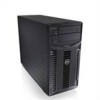Dell PowerEdge T410 Hardware Owner's Manual - Page 58
Warning Messages
 |
View all Dell PowerEdge T410 manuals
Add to My Manuals
Save this manual to your list of manuals |
Page 58 highlights
Table 1-3. System Messages (continued) Message Causes Corrective Actions Warning! Unsupported memory configuration detected. The memory configuration is not optimal. The recommended memory configuration is: Invalid memory configuration. The system will run but with reduced functionality. Ensure that the memory modules are installed in a valid configuration. See "General Memory Module Installation Guidelines" on page 106. If the problem persists, see "Troubleshooting System Memory" on page 162. Write fault Write fault on selected drive Faulty USB device, USB Replace the USB medium or medium, optical drive device. Ensure that the USB, assembly, hard drive, or hard- SAS backplane, or SATA drive subsystem. cables are properly connected. See "Troubleshooting a USB Device" on page 156, "Troubleshooting an Optical Drive" on page 165, and "Troubleshooting a Hard Drive" on page 167. NOTE: For the full name of an abbreviation or acronym used in this table, see the "Glossary" on page 187. Warning Messages A warning message alerts you to a possible problem and prompts you to respond before the system continues a task. For example, before you format a diskette, a message will warn you that you may lose all data on the diskette. Warning messages usually interrupt the task and require you to respond by typing y (yes) or n (no). NOTE: Warning messages are generated by either the application or the operating system. For more information, see the documentation that accompanied the operating system or application. 58 About Your System















